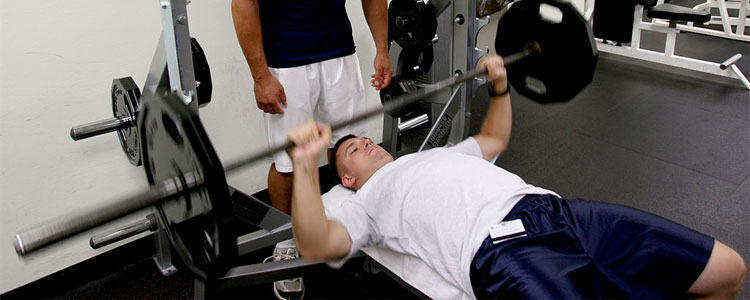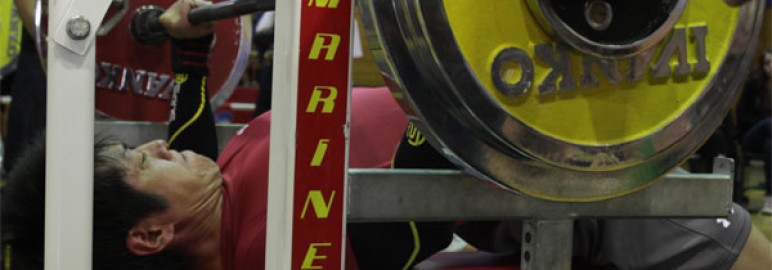1. Do NOT Pinch Your Shoulder Blades Together (as hard as possible)
This may go against everything you’ve ever been told about the bench press so keep reading. Pinching your shoulder blades together (forcefully retracting your scapulae) is a cue meant to help you do a number of things:
- Put the shoulders in a safer position
- Reduce the lifts range of motion (ROM)
- Utilize the right muscle groups (notably the lats) for a stronger, safer press
Pinching your scaps together isn’t always wrong. It’s actually a great cue to use with beginner lifters who are still in the early stages of training, developing kinesthetic awareness, and mastering technique. As you progress into more of an intermediate/advanced lifter, however, pinching your scaps together as hard as possible will become counterproductive.

Why?
A number of reasons but, notably, full retraction of the scapulae isn’t necessary for lat recruitment. In fact, fully retracting the scapulae makes it harder to use the lats properly which inhibits bench performance. On the other hand,forcefully depressing the scapulae is necessary for lat recruitment.
So what should you do?
Rather than forcefully retract your scaps, focus on emphasizing scapular depression (put your shoulder blades in your back pockets) throughout the entire lift. At the same time, you should slightly retract your shoulder blades but do not actively pinch them together as that takes the focus away from scapular depression and subsequent lat recruitment.
Your Takeaway: Pinching your shoulder blades together as hard as possible is NOT necessary for optimal bench performance and may inhibit your strength. Instead, focus on scapular depression (put your shoulder blades in your back pockets) with slight scapular retraction. This technique will help to recruit your lats and maintain the best position throughout the entire lift.
2. Pause on Your Chest
Where do you usually fail when you bench press? On your chest? Maybe a couple inches above? That’s totally normal and where most lifters tend to get stuck. Some develop sticking points near lockout but those instances are few and far between. If you’re weak off your chest and need to develop more starting strength, incorporating the pause bench press into your training program is a smart move.
How Do You Pause Bench Press? Simple.
Un-rack the bar. Lower it to your chest. Pause for the prescribed time period. Press it back up. Repeat. Seriously, it’s that simple. Don’t overcomplicate it.
How Long Should You Pause For? Lets say anywhere between 2-4 seconds keeping in mind this doesn’t mean count as fast as you possibly can and pretend to pause for 2-seconds when you really just bounce the bar off your chest.

How Do You Program the Pause Bench Press?
Use it as your 1st or 2nd exercise of the day on upper body strength training days. You can use a variety of set/rep schemes (I’ll give you a few of my favorites below) but make sure to do it near the beginning of your training session so you’re fresh and able to maintain perfect form.
As for set/rep schemes, it all depends on your goal. Here are some examples noting there isn’t a single “best” set/rep scheme. Rather, the “best” one depends entirely on your needs, goals, and preferences at any given time.:
For hypertrophy/volume: 3-5 sets of 8 reps with a 2-sec pause on your chest
For strength/hypertrophy: 3-5 sets of 5 reps with a 3-sec pause on your chest
For strength: 3-5 sets of 2-3 reps with a 2-sec pause on your chest
An intelligent combination of all set/rep schemes (rather than solely focusing on a single one) over a period of time will yield the best results in overall strength, hypertrophy, and performance.
Your Takeaway: If you want to get better at benching you’d be wise to add the pause bench press into your training repertoire. Not only will it directly target the most common sticking point, it also improves starting strength and forces you to slow down and focus on using perfect form.
3. Train the Bench Press with High(er) Volume – Use Clusters!
Everyone knows 1-5 reps is where “max strength” is built so if you want to get stronger you need to stay in that rep range, right? Wrong.
Venturing into the higher repetition ranges (6-8…sometimes even 10’s) is extremely beneficial for jacking up your bench press. Heavy sets of 1-5 reps are obviously important and hold major significance within your program, but neglecting higher repetition ranges and overall volume will destroy your progress.
How do you train your bench press with higher volume? Cluster Sets.

Cluster sets are a quick and simple – not easy – way to accrue a huge amount of volume at a relatively high training intensity.
Fair warning: they’re brutal. Offensively difficult. Absolutely horrible. But they work really, really well.
What’s a cluster?
A cluster involves performing several “mini sets” in order to complete 1 “full set.” To illustrate, let’s look at a normal set/rep scheme (3 x 6) and break it into a cluster.
Using 3 x 6 as the example, we know each set is comprised of 6 total reps. But instead of performing all 6-reps in a row, a cluster would involve performing smaller sets of 1, 2, or 3 reps until you complete all 6.
To illustrate, below are 3 sample clusters:
- 3 x 1-1-1-1-1-1
- 3 x 2-2-2
- 3 x 3-3
*Rest 10-15 seconds between each cluster. Rest 2-4 minutes between each set.
See how it works? The total number of repetitions per cluster varies, but every cluster still comes out to a total of 3 sets of 6 repetitions.
Why are clusters beneficial?
They’re a quick and effective way to increase the total volume of your training session. More importantly, performing fewer repetitions per set allows you to accomplish two important things:
- You can handle more weight. Needless to say, fewer reps per set will allow you to handle heavier loads which facilitates more repetitions at a higher percentage of your 1-repetition maximum (1RM).
- You ingrain perfect form. Performing fewer reps per set allows you to focus on using perfect technique without fatiguing as you would during a standard high-rep set. Of course, practicing perform form at a relatively high training intensity and volume will drastically improve the skill set (because it is a skill) of using perfect form under maximal loads.
Want a Sample 4-Week Cycle of Bench Press Clusters?
Below is a sample 4-week cycle of one of my favorite bench press cluster progressions.
Replace your main bench press movement with this cluster cycle for the next 4-weeks then re-test your max to see how much you’ve improved.
Week 1: 4 x 2-2-2 (as heavy as possible while maintaining perfect form)
Week 2: 3 x 2-2-2 (as heavy as possible while maintaining perform form)
Week 3: 4 x 2-1-1 (as heavy as possible while maintaining perform form)
Week 4: 3 x 2-2-2 (moderate difficulty – not too hard)
Week 5: Re-test your 1-5RM
Remember, cluster sets are extremely effective but brutally difficult.
Follow these 3 hacks and watch your bench quickly improve!
For more visit BretContreras or more by the original author Jordan Syatt








![Skip These 5 “Healthy” Foods! Seriously! [VIDEO]](http://FitPhreak.com/wp-content/uploads/2016/03/Skip-These-5-Healthy-Foods-Seriously-223x145.jpg)



